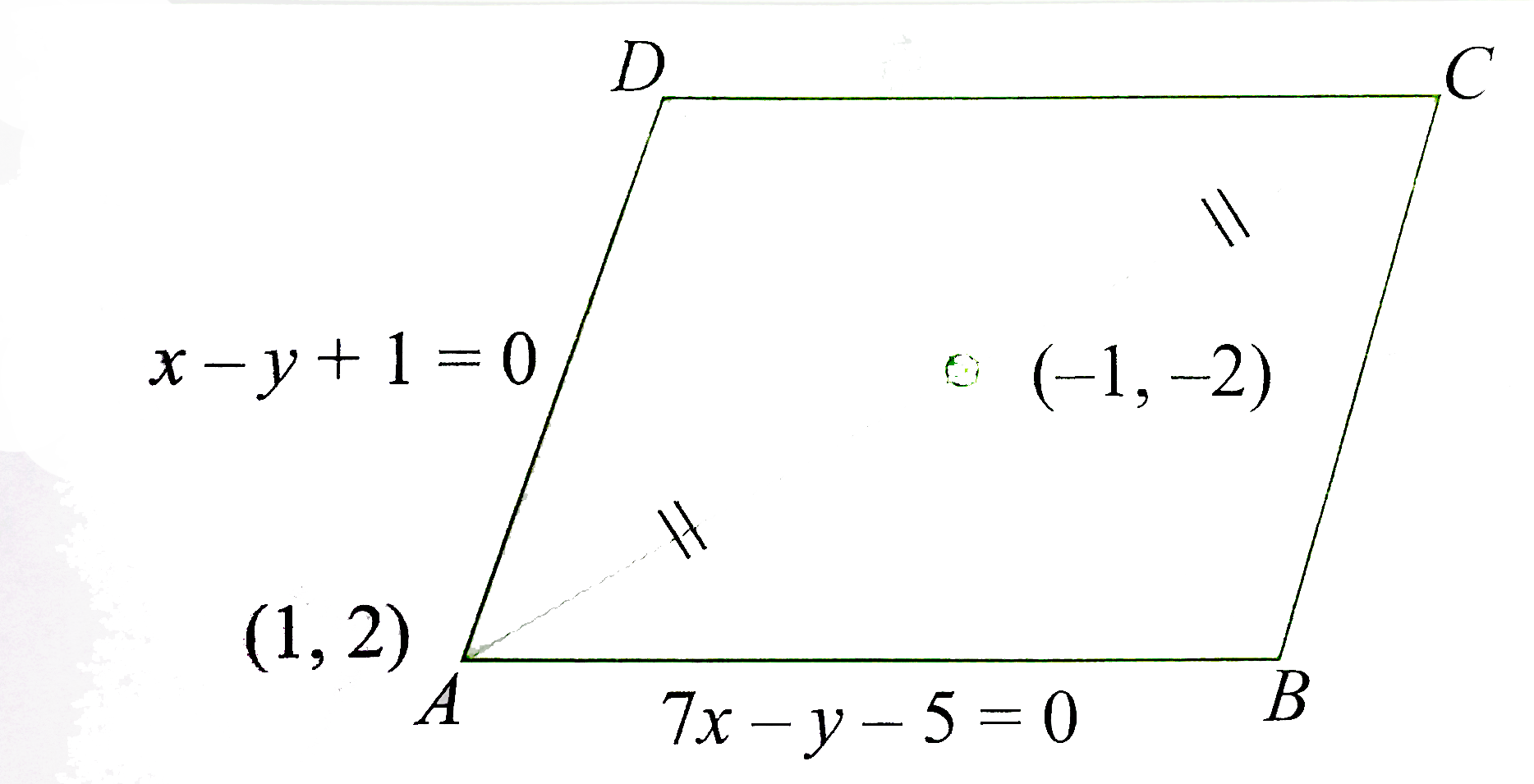Two sides of a rhombus are along the lines,x−y+1=0 and 7x−y−5=0 . If its diagonals intersect at (−1,−2) , then which one of the following is a vertex of this rhombus ? (1) (−3,−9) (2) (−3,−8) (3) (13,−83) (4) (−103,−73)Solution in Tamil
(-3, -8)
(13,−83)
((−103,−73)
(-3, -9)
The correct Answer is:B

On solving equation of AB and AD, vertex A(1, 2)
∵(−1,−2) is midpoint of AC, vertex C is (−3,−6).
Line BC is parallel to AD passing through point C, hence its equation is x-y-3 =0
Line DC is parallel to AB passing through ponit C, hence its equation is 7x-y+15=0
Hence other vertices are
B(13,−83) and D(−73,−43)
Topper's Solved these Questions
- BOOK - CENGAGECHAPTER - STRAIGHT LINESEXERCISE - JEE Advanced Previous Year4videos
STRAIGHT LINES
- BOOK - CENGAGECHAPTER - STRAIGHT LINESEXERCISE - Exercise (Numerical)13videos
STRAIGHT LINES
- BOOK - CENGAGECHAPTER - STRAIGHT LINEEXERCISE - Multiple Correct Answers Type8videos
STRAIGHT LINE
- BOOK - CENGAGECHAPTER - THEORY OF EQUATIONSEXERCISE - JEE Advanced Previous Year9videos
THEORY OF EQUATIONS
Similar Questions
about to only mathematics
06:22View Solutionstraight line L with negative slope passes through the point (9,4) cuts the positive coordinate axes at the point P and W As L. Varies, find the minimum value of |OP|+|OQ| , where O is origin .
07:56View SolutionThe point P(α,α+1) will lie inside the triangle whose vertices are A(0,3),B(−2,0) and C(6,1) if
10:48View SolutionQ. Let p and q real number such that p≠0,p2≠q and p2≠−q. if α and β are non-zero complex number satisfying α+β=−p and α3+β3=q, then a quadratic equation having αβ and βα as its roots is
06:06View SolutionTwo sides of a rhombus are along the lines, x-y+1=0 and 7x-y-5=0. If its diagnols intersect at (-1,-2), then which one of the following is a vertex of a rhombus? a. (−3,−9) b. (−3,−8) c. (13,−83) d. (−103,−73)
06:30View SolutionTwo sides of a rhombus are along the lines,x−y+1=0 and 7x−y−5=0 . If its diagonals intersect at (−1,−2) , then which one of the following is a vertex of this rhombus ?
06:47View SolutionTwo sides of a rhombus are along the lines x - y + 1 = 0 and 7 x - y - 5 = 0 . If its diagonals intersect at ( - 1, -2) , then which one of the following is a vertex of this rhombus ?
09:00View SolutionTwo sides of a rhombus ABCD are parallel to the lines y = x + 2 and y = 7x + 3. If the diagonals of the rhombus intersect at the point (1, 2) and the vertex A is on the y-axis, find the possible coordinates of A. x – y – 1 = 0 are the equations of two internal bisectors of its angles.
04:56View SolutionThe sides of a rhombus ABCD are parallel to the lines x−y+2=0 and 7x−y+3=0, If the diagonals of the rhombus intersect at P(1,2) and the vertex A (different from the origin) is on the y-axis then the ordinate of A is:
07:41View Solutionयदि एक समचतुर्भुज की दो भुजाएं रेखाओ x−y+1=0 तथा 7x−y−5=0 की दिशा में है तथा इसके विकर्ण बिन्दु (−1,−2) पर प्रतिच्छेद करते हैं, समचतुर्भुज का निम्न में से कौन-से शीर्ष है
04:14View SolutionTwo sides of a rhombus ABCD are parallel to the lines y = x + 2 and y = 7x + 3 If the diagonals of the rhombus intersect at the point (1, 2) and the vertex A is on the y-axis, then vertex A can be
06:47View SolutionTwo sides of a rhombus ABCD are parallel to the lines y = x + 2 and y = 7x + 3 If the diagonals of the rhombus intersect at the point (1, 2) and the vertex A is on the y-axis, then vertex A can be
View SolutionTwo sides of a rhombus are along the lines,x−y+1=0 and 7x−y−5=0 . If its diagonals intersect at (−1,−2) , then which one of the following is a vertex of this rhombus ? (1) (−3,−9) (2) (−3,−8) (3) (13,−83) (4) (−103,−73)
04:16View SolutionTwo sides of a parallelogram are along the lines x + y = 3 and x - y + 3 = 0. If it intersects on its diagonal (2, 4), it has a vertex.
11:28View SolutionIf two sides of a rhombus lines x-y +1 =0 And 7x - y 5=0 Is in the direction of and its diagonal point (-1,-2) But the intersection is karte, which of the following vertices of rhombus is
07:19View Solution

